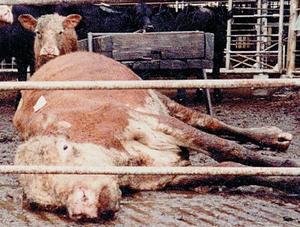Public healthReport: DHS underestimates risks of accidental pathogen release at Kansas BioLab
Manhattan, Kansas, is the proposed location of a new, $450 million BioLab44 DHS research facility; a National Academy of Sciences panel report says that a risk assessment by DHS of the new facility vastly underestimates the risk of an accidental pathogen release from the lab and the associated costs; the NAS report also said last month’s analysis failed to learn from fifteen major accidental releases of the foot and mouth virus around the world

Concerns over accidently-released pathogens // Source: blogspot.com
We wrote earlier in the week about the growing scrutiny the assessment by DHS of the risks associated with the proposed BioLab-4 in Manhattan, Kansas, is drawing (“Safety of planned Kansas Biosafety-Level 4 lab questioned,” 16 November 2010 HSNW).
Andy Coghlan offers a useful update. He notes that according to a report issued last week, the risks associated with holding foot and mouth disease (FMD) virus at a proposed animal disease research lab are greater than previously predicted.
The U.S. government last month estimated there to be a 70 percent chance of an accidental escape over the planned 50-year lifetime of the National Bio and Agro-Defense Facility in Manhattan, Kansas, and that the cost of a release would be $9 billion to $50 billion.
Now the U.S. National Academy of Sciences (NAS) says the risk of a release and the associated costs could be significantly higher than suggested in the Department of Homeland Security’s previous report.
“Our overall assessment is that the DHS’s risk assessment is incomplete, and is not entirely adequate or valid,” says Ron Atlas of the University of Louisville in Kentucky, who chaired the NAS report panel.
The report says that the DHS underestimated the potential for the virus to escape on particles of dust, from staff and from huge rooms housing large live animals for experimentation. This is an arrangement for which there is no precedent, and so for which there is no data on risks of release, it says.
“Every day, with animals exhaling the virus, it’s a much higher bio-burden to deal with than a simple spillage,” says panel member Jack Roth of Iowa State University in Ames.
Another weakness of the DHS analysis was an inadequate assessment of the risks associated with the fact that 10 percent of the country’s cattle are grazed within 300 kilometers of the site. “If the virus that causes FMD escaped, it’s likely it would reach distances far away before we knew it had escaped,” says Roth.
The NAS report also said last month’s analysis failed to learn from fifteen major accidental releases of the foot and mouth virus around the world.
Nor did the DHS state what steps would be taken to monitor for escapes and to react should one occur. The academy accuses the DHS of being “overly optimistic” in assuming that an outbreak could be contained by culling 120 to 720 herds per day.
Congress must now decide whether to release funds for the project, which have been frozen pending completion of the NAS and DHS reports.
